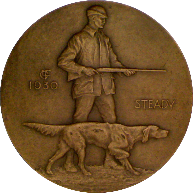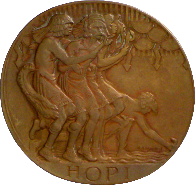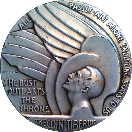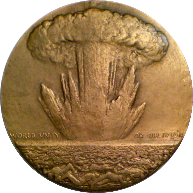Society of Medalists
The Society of Medalists unquestionably represents the United States' longest running and most successful art medal society. Co-founded in 1929 by Clyde Curlee Trees, the new owner of Medallic Art Company, and medal enthusiast and philanthropist George Dupont Pratt, the Society saw itself as the successor to the Circle of Friends of the Medallion and modeled itself on recently established peer groups in France (Société des Amis de la Médaille Française) and in the Netherlands (Verenigung voor Penningkunst). Advances in minting technology had enabled the inexpensive production of high quality bronze medals. This allowed the newly founded Society to pursue its mission of promoting high quality yet affordable medallic art to a broad public.
Affordability and material quality were guaranteed by the Medallic Art Company's excellent production facilities in New York. Thus the founders had to focus on ensuring the medallions' artistic merit and broad appeal. They chose to recruit a committee of highly reputed sculptors who solicited medal designs from sculptors of the highest caliber. The competing artists were usually provided with a general topic deemed to be popular with the member community and invited to submit their proposals to the Society. The Society's artistic selection committee then voted on the proposals and the winning design was issued. Originally, only American sculptors were invited to submit proposals and prior winners were not eligible to submit future proposals. In later years, the committee changed its policies and allowed previous winners and well-known international sculptors to compete for new medal issues.
Starting in 1930, the Society (mostly) managed to maintain a schedule of two medal issues per year. During its 66 years of existence, it issued a total of 139 different medals. Of these, 134 were regular issues (one issue consisting of six separate medals) and 5 were special issues. With the exception of one year at the height of World War II, all original medals were issued in bronze. The general metal shortage during World War II required a departure from this practice, resulting in two smaller diameter silver medals. In the 1970s, the Medallic Art Company started issuing silver variants of the older bronze medals. With the exception of the war-time silvers, all silver variants of early issues represent restrikes from the 1970s and 1990s. The Society and Medalic Arts Company tried to popularize and revitalize their brands by issuing various items based on particularly popular earlier medals. These efforts yielded the commercially unsuccessful, and therefore of course collectible, paperweights.
While many medal series are defined by one over-arching topic and a designated sculptor, the Society of Medalists series represents a truly diverse body of work. Every medal had its own topic which gives us an idea about pressing issues or popular leitmotifs of the day. Also, with a few exceptions, every medal was designed and sculpted by a different artist, each bringing his own philosophy, style, and technique to the series. All styles of the 20th century, be they classic, abstract, or modern can be found in this series.
The end came in 1995 after the Medallic Art Company had been resold twice. The Society was already in trouble because the last issues had been expensive to produce and did not meet with the same widespread approval that the earlier issues had. While the medals were still of very high material and artistic quality, the decision makers had started neglecting two key points: affordability and broad appeal. The last medals of the series were simply too expensive and too large for the average collector. In the last ownership transition the already shrunken member list was apparently not included in the list of purchased assets and no further medals were commissioned. A sad end for an organization that brought so much beauty to so many people.
Collecting Society of Medalists
For the collector, the Society of Medalists series is very attractive for many reasons:
- The medals are highly appealing and very decorative. Many are represented in museum and college collections.
- In general, the medals are in the affordable $30 to $60 range with some in the $100 to $200 range and the few most expensive ones trading for $400 to $900 dollars. If you are savvy and take your time, you can definitely build a complete collection (not including variants) for around $10,000.
- There is a fair amount of trading at almost all times, so it won't take you forever to build or dispose of your collection by dealer or auction.
- The medals have held their value well over time.
- Most issues have a fairly small mintage of 750 to 1,000, creating a somewhat scarce but definitely not unobtainable resource.
- Once you have completed your basic collection, you can branch out into the variants. Many medals exhibit variations in patina and edge lettering, depending on where and when they were struck.
- There is an authoritative guide in the form of David Thomason Alexander's book that tells you all you want or need to know about the medals.
But most of all, the medals are really enjoyable and that's of course the only reason you should collect them. If you hold them for a long time, they probably won't be a bad investment either.
As a little teaser, I have included a mosaic of (most of) the Society of Medalists medals below. If you like what
you see here you should definitely look at the other sections of this page.

Next Steps
- Take a look at all the medals in the other tabs of this page. There are two tabs that lead to pictures: Medals and Variants. The Medals tab leads to a long list medal images, both obverse and reverse. The Variants tab leads to a grid of obverse medal images. You can configure the grid to ignore some variations while paying atttention to others. For example, you can select that you don't care about differences in edge lettering but do care about differences in patina.
- Contact me if you are interested in buying or selling medals or want to help me improve the site. I am always interested in buying to complete or improve my own collection. Sometimes I have duplicates that I would be willing to sell. If you cannot or will not sell medals that I still need, at least share your high-quality pictures so I can complete the Variants display section. If I don't have a picture for a medal, I don't have the medal in my collection and I would be interested in buying it.
- Check out the links in the Resources tab.
- Support this site with a small donation if you appreciate it as a resource and want to help me with hosting and bandwidth costs.
The table below contains both the obverse and the reverse of all 139 Society of Medalists issues. Many of the issues exist in more than one variant. Click on the Variants tab for an obverse view of these variations.
Loading variants might take a little bit of time. Please wait...
Contact me if you have links that might merit inclusion on this page or if you want to be listed as an auctioneer or dealer.
Additional Information
Auctioneers
Books
Dealers
Contact me if you want to post a have/need message or another community-related message here.
-
1/2/2015 Looking for most silver SOM medals.
-
1/2/2015 Looking for medals by SOM artists.



